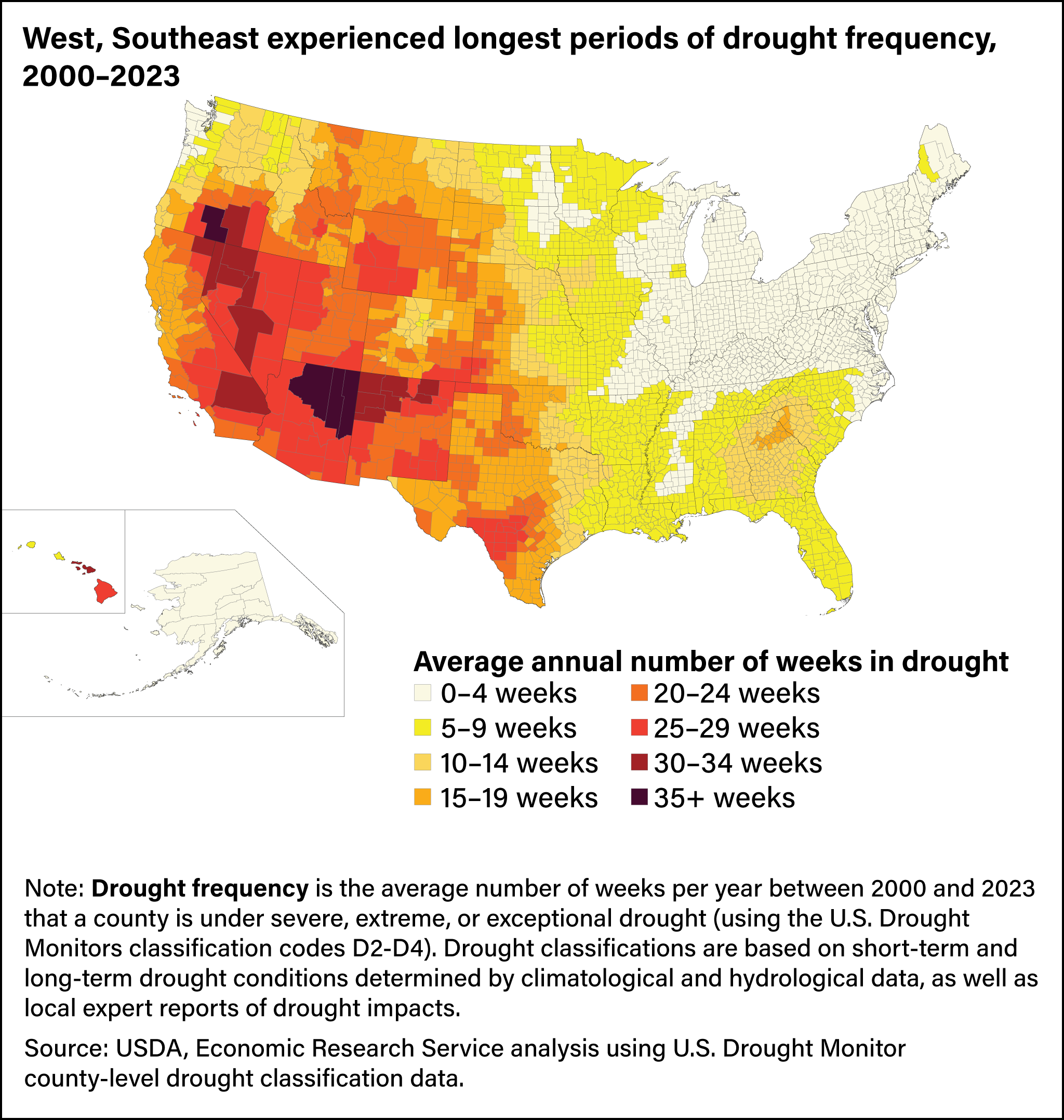
Drought and Related Farm Bill Programs
- by Nicholas Potter and R. Aaron Hrozencik
- 9/5/2024
Drought is a prolonged period of abnormally low precipitation that can have substantial impacts on agricultural production, resulting in reduced dryland crop yields and increased water application rates on irrigated crops. Drought can also reduce stream flows and lead to less snowpack, affecting available water supplies. Drought can occur throughout the United States but is most prevalent in the western half of the country, where most counties have experienced an average of at least 10 nonconsecutive weeks per year of severe, exceptional, or extreme drought from 2000 to 2023 as measured by their historical precipitation, evaporation, and transpiration patterns. Some counties in Arizona, California, New Mexico, Nevada, and Oregon have experienced 30 or more weeks of drought on average from 2000–2023. Some counties in Florida, Alabama, Georgia, North Carolina, and South Carolina experience severe, exceptional, or extreme drought conditions on average in at least 10 weeks per year.
The Farm Bill has authorized several programs designed to reduce risks posed by drought, including the Federal Crop Insurance Program; the Emergency Conservation Program; the Pasture, Rangeland, and Forage Program; and the Livestock Forage Disaster Program. These programs provide relief to farms and ranches experiencing drought. In addition, the Environmental Quality Incentives Program (EQIP) provides assistance to farm operations to conserve water and for other conservation measures. Some EQIP assistance is targeted toward water-conserving efforts in drought-prone regions through the WaterSMART Initiative, a collaboration between the U.S. Department of Agriculture and the U.S. Department of the Interior’s Bureau of Reclamation.
This article is drawn from:
- Wallander, S., Hrozencik, R.A. & Aillery, M. (2022). Irrigation Organizations: Drought Planning and Response. U.S. Department of Agriculture, Economic Research Service. EB-33.
- Hrozencik, R.A. & Aillery, M. (2021). Trends in U.S. Irrigated Agriculture: Increasing Resilience Under Water Supply Scarcity. U.S. Department of Agriculture, Economic Research Service. EIB-229.
You may also like:
- Wallander, S., Hrozencik, R.A. & Aillery, M. (2022, February 22). Some Irrigation Organizations Rely on Formal Drought Plans. Amber Waves, U.S. Department of Agriculture, Economic Research Service.
- Hrozencik, R.A. & Aillery, M. (2022, January 12). Trends in Irrigated Agriculture Reveal Sector’s Ability To Adapt to Evolving Climatic, Resource, and Market Conditions. Amber Waves, U.S. Department of Agriculture, Economic Research Service.
- Potter, N., Hrozencik, R.A. & Wallander, S. (2023, October 11). Water Delivery Organizations Convey Much of the Water Used for Irrigation in the Western United States. Amber Waves, U.S. Department of Agriculture, Economic Research Service.
- Hrozencik, R.A., Potter, N. & Wallander, S. (2023, May 22). Groundwater Organizations Promote Aquifer Stewardship for U.S. Agriculture. Amber Waves, U.S. Department of Agriculture, Economic Research Service.
- Hrozencik, R.A. (2024). Drought in the western United States. U.S. Department of Agriculture, Economic Research Service.


